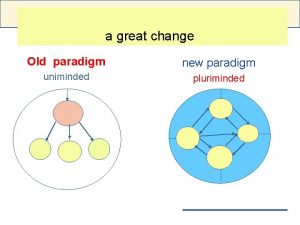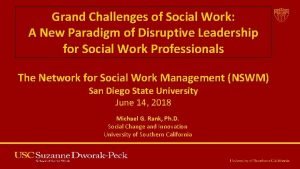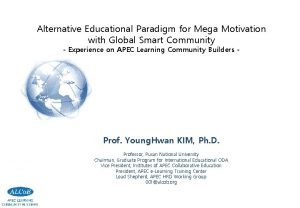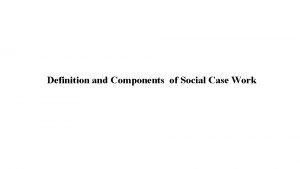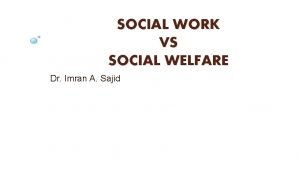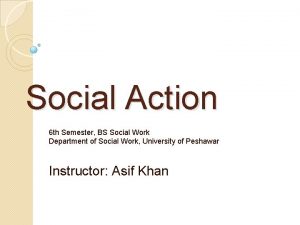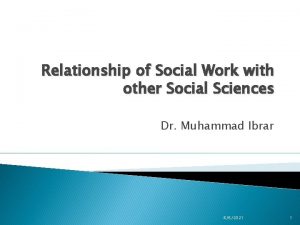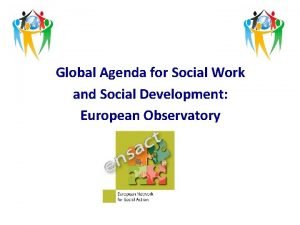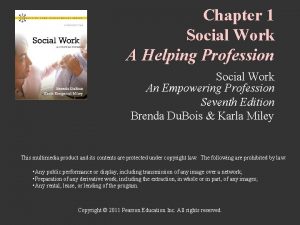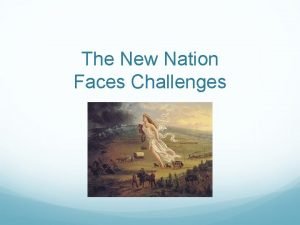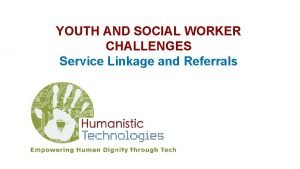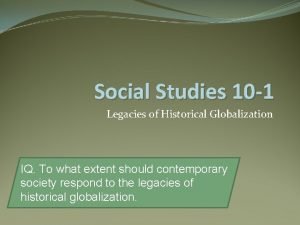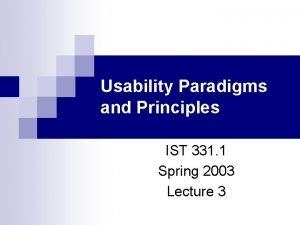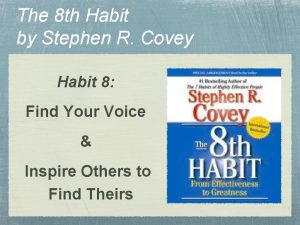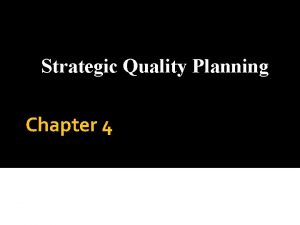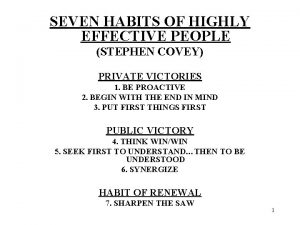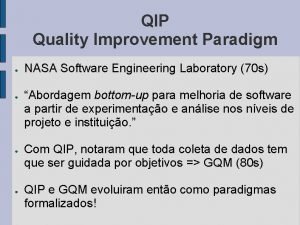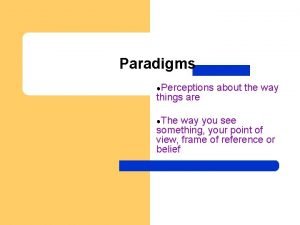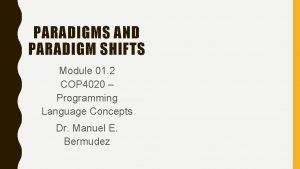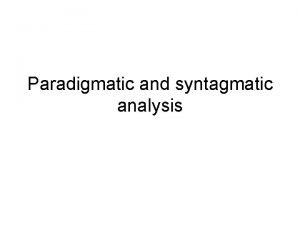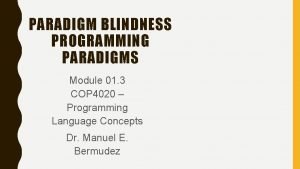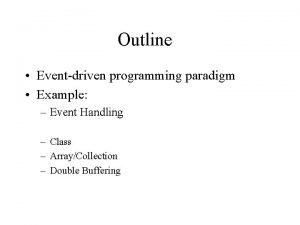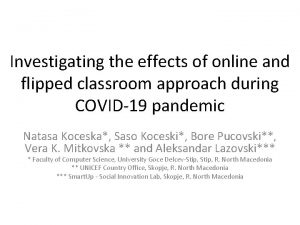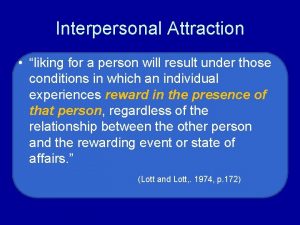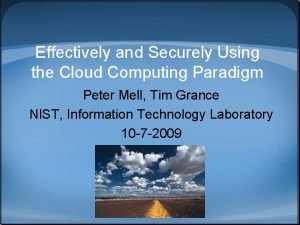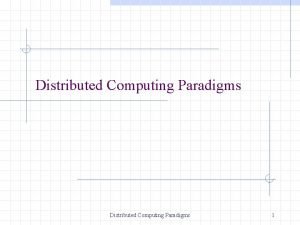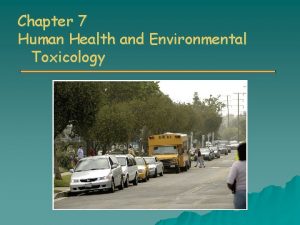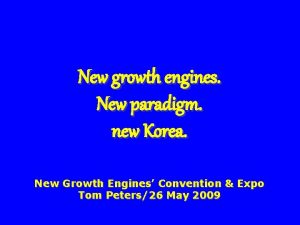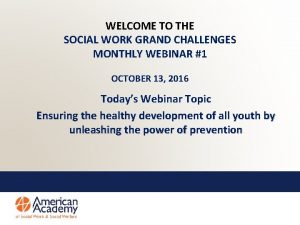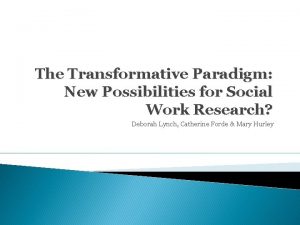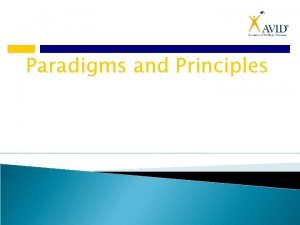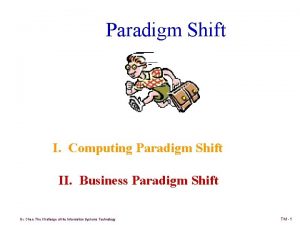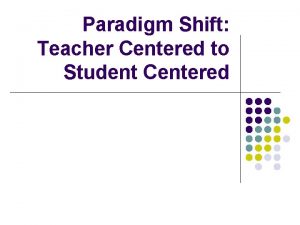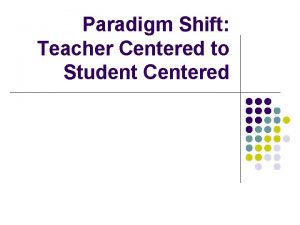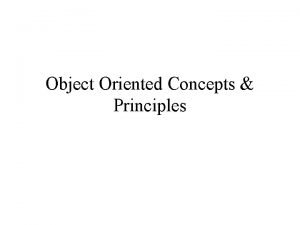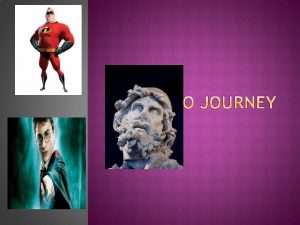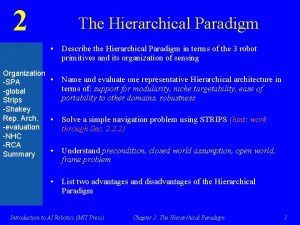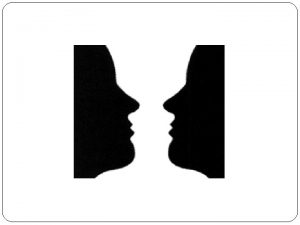Grand Challenges of Social Work A New Paradigm














































- Slides: 46

Grand Challenges of Social Work: A New Paradigm of Disruptive Leadership for Social Work Professionals The Network for Social Work Management (NSWM) San Diego State University June 14, 2018 Michael G. Rank, Ph. D. Social Change and Innovation University of Southern California

Grand Challenges of Social Work & United Nation’s 17 Sustainable Development Goals for 2030 GCSW & GCSW UNSDG UNSDG create leadership challenges for a New, Evolving, & Changing Practice Environment

Grand Challenges of Social Work Led by the American Academy of Social Work and Social Welfare (AASWSW), the Grand Challenges for Social Work are “groundbreaking initiatives to champion social progress powered by science”. The 12 Grand Challenges for Social Work represent a dynamic social agenda, focused on improving individual and family well-being, strengthening the social fabric, and helping create a more just society. http: //aaswsw. org/grandchallenges-initiative/

AASWSW Articulating the Grand Challenges will accelerate social innovations to address wicked problems in our society. One of the aspirations of the Grand Challenges is to build a more cohesive society that fights exclusion and marginalization, creates a sense of belonging, promotes trust, and offers pathways for social and economic mobility for everyone.

AASWSW: The 12 Grand Challenges Health Ensure healthy development for all youth Advance long & productive lives Close the health gap Stop family violence Well Being End homelessness Eradicate social isolation Harness technology for the social good Create social responses to a changing environment Equity Promote smart decarceration Build financial capability for all Achieve equal opportunity & justice Reduce extreme economic inequality

United Nation’s 17 Sustainable Development Goals for 2030: https: //sustainabledevelopment. un. org/? menu=1300 • • • No Poverty • Reduced Inequities Zero Hunger • Responsible Consumption and Production Good Health and Well Being • Climate Action Quality Education • Life Below Water Gender Equality • Life on Land Clean Water and Sanitation • Peace and Strong Institutions Affordable and Clean Energy • Sustainable Cities and Communities Decent Work and Economic Growth • Partnerships for the Goals Industry, innovation, and Infrastructure

Grand Challenges & Wicked Problems The Grand Challenges of Social Work are major goals we try to accomplish as social work professionals. Wicked problems are individual issues that must be resolved to solve a Grand Challenge. For example: End homelessness is a Grand Challenge. The wicked problems related to homelessness can be: poverty, racism, unemployment, recent release from prison, etc. ~Harry Hunter

Wicked Problems Other examples of wicked problems addressed in scholarly literature include: poverty, racism, health care, urban renewal, domestic violence, sex trafficking, dementia, environmental & natural resources policy etc. http: //www. provost. usc. edu/initiatives/wicked-problems/ http: //www. provost. usc. edu/initiatives/wicked-problems

Wicked Problems have six key properties: (1) Multi-dimensional; (2) Multiple causes; (3) Multiple symptoms; (4) Multiple solutions (5) Have multiple stakeholders; and are (6) Constantly evolving” Reference: Watkins, A. & Wilber, K. (2015). Wicked & wise: How to solve the world’s toughest problems. Great Britain: Urbane Publications. (Watkins & Wilber, 2015, pp. 16 -29).

Wicked Problems Wicked problems refers to complex issues that are, by nature, resistant to resolution. Characteristics of wicked problems include the following: • The problem is not understood until after the formulation of a solution. • Wicked problems have no stopping rule, you cannot say for sure that you are done with the problem. • Solutions to wicked problems are not right or wrong. • Every wicked problem is essentially novel and unique. • Every solution to a wicked problem may be a 'one shot operation. ' • Wicked problems have no given alternative solutions.

Grand Challenges of Social Work Social work practice leaders are challenged to quickly understand integrate: ● the Grand Challenges; ● How to lead in a new era of practice informed by the Grand Challenges; ● how the impact of GCSW potentially changes traditional models of service delivery.

Grand Challenges of Social Work How will the social work practice environment respond? Some examples follow…

Social Work Policy Institute • NASW

CSWE: Practice Innovations ● The Bridge Model of Transitional Care ● Health Home Connect ● Missouri Quality Initiative for Nursing Homes(MOQI) ● Shared Decision Making for Long Term Services & Supports

The Bridge Model of Transitional Care The Bridge Model is an evidence- and social work-based transitional care intervention designed for older adults discharged from an inpatient hospital stay. Review: www. transitionalcare. org https: //www. cswe. org/getattachment/Centers. Initiatives/Centers/Gero-Ed-Center/Educational. Resources/Practice Innovations/Bridge. Overview_May 2014. pdf. aspx https: //www. cswe. org/getattachment/Centers-Initiatives/Centers/Gero-Ed. Center/Educational-Resources/Practice. Innovations/Bridge. Model. Presentation_June 2014. pdf. aspx

Health Home Connect was developed by the Los Angeles Downtown Women's Center to identify homeless, older adult women and enroll them in Medicaid by linking the Affordable Care Act (ACA) and the US Department of Housing and Urban Development (HUD)’s Coordinated Entry System (CES) housing system. Read the Health Home White Paper: Connect https: //www. cswe. org/getattachment/Centers-Initiatives/Gero-Ed-Center/Teaching. Tools/Practice-Innovations/Health_Home_Connect_White_Paper_(Feb 2015). pdf. aspx Visit the Downtown Women's Center website: website https: //www. downtownwomenscenter. org/

Missouri Quality Initiative for Nursing Homes (MOQI) MOQI utilizes a combination of interprofessional expertise, including gerontological social workers, to install an information network to share health information between clinicians and hospitals and view clinical care documents to facilitate outcomes. Visit the MOQI website: http: //nursinghomehelp. org/moqi. html

Shared Decision Making for Long Term Services and Supports Shared decision making as a collaborative, person-directed approach designed for older Veterans—but valuable for all older people—to use in making plans and choices about long term services and supports. View: https: //va. gov/GERIATRICS/Guide/Long. Term. Care/Shared_Decision_Making. asp Visit: https: //www. va. gov/geriatrics/ for patient-facing information https: //va. gov/GERIATRICS/Guide/Long. Term. Care/index. asp

Paradigm Shifts: Innovations? ? ? ● Brief Therapy ● Managed Care ● Women's Issues ● Wrap Around Services ● Evidence Based Practice ● Trauma-Informed Practice

Paradigm Shifts: Innovations? ? ? • • • Social Systems Theory (1974)…holons On Line Social Work Education Telehealth (Virtual Practicums/Practice) MOOC’s Social Work APP’s for consumers 12 Grand Challenges of Social Work (2016)

MOOC Massive Open Online Course’s ● Unlimited participation and open access via the web free. ● Traditional course materials, filmed lectures, readings, and case studies are offered. ● MOOCs provide interactive user forums to support community interactions among students, professors, & teaching assistants. ● MOOCs were first introduced in 2006 and have become a popular and successful mode of learning and free education.

Research AASWSW Grand Challenges Executive Committee on Learning and Education is conducting a survey of Deans and Directors of CSWE Programs of Social Work to investigate the integration of the 12 Grand Challenges into social work curricula at all levels.

Disruptive Leadership Disruptive/Innovative Leadership is needed To respond to the Grand Challenges. Do we have the courage?

Disruptive Leadership What defines a disruptive leader? Someone in a leadership position who articulates vision; is always looking for better solutions and ways to improve processes as well as the mission overall; and isn’t afraid to shake things up to get the necessary results. Jane Addams, Mary Parker Follett, Steve Jobs, Bill & Melinda Gates, and Ursula Burns are all famous disruptors. and Ursula Burns Their action leadership styles and creative visions are known for brutal honesty

Integrative Model of Executive Skills HIGH M A N A G E M E N T LOW High Management Low Leadership Low Management High Management High Leadership Low Management Low HIGH L E A D E R S H I P

Integrative Model of Executive Skills: Low Leadership, Low Management = Laissez Faire High Leadership, Low Management = Visionary Low Leadership, High Management = Task Master High Leadership, High Management = Fully Engaged

Leadership and Management Think of leadership and management as a double helix. Separate executive functions, yet integrally connected. Moving through time and space interdependently; at times the functions appear to share moments and are interconnected; but most times they are spherically opposed. Yet one cannot exist without the other. Leadership needs management and management needs leadership.

Integrative Model of Executive Skills • Each relationship describes a situation where the two functions interact to create a working environment. • The work environment is an application or practice of the interconnection. • There are times where the combined approach may be effective and times when it can be counterproductive. • There are no values attached to the interaction of the combined skills.

Integrative Model of Executive Skills • Where there is the combination of low leadership skills and low management skills, the working environment may be considered skills Laissez Faire. • That is, there may be no use for leadership or management as individuals are self-starters and require no environmental impetus. • Indeed, any attempt at leadership or management may be construed as micro management and counterproductive. • Alternatively, in situations where leadership and management is required, the lack thereof may lead to chaos, disequilibrium, or entropy.

Integrative Model of Executive Skills • In situations where there are high leadership skills and low management skills required, can be conducive to the need for vision and action • In this scenario, management may not be required for the task to be accomplished; rather a strong communicated vision is vision needed to move followers into action. • Or management may have fallen into disarray, lacking structure, and needing stimulation.

Integrative Model of Executive Skills • The practice of low leadership and high management may lend to the need for a task master; a person that can get work done without the need for vision. • Or leadership may be weak or nonexistent, and the success of the mission needs a task orientation and no task orientation clear need for a leader. • In this case the manager becomes a leader

Integrative Model of Executive Skills • Where there is the presence of high leadership skills and high management skills, the operation may be seen as management skills fully engaged or synergistic • This may be considered the ideal situation, as it becomes synergistic; the inputs actually exceeding the sum of the parts. • Conversely, where there is no need for either, the system can become entropic.

New Model of Disruptive Leadership • High Leadership, High Management skills • Transorganizational Collaboration • For-Benefit Sector (Blurring of the sectors) • Developing Complex partnerships, • Initiating Social entrepreneurship, • Implementing Failure by design; • Creating a Change strategy, • Building & planning for change, • Leading system implementation, • Maintaining organizational equilibrium, • Leading through conflict & chaos.

Transorganizational Collaboration • We are witnessing a major confrontation to the rugged individualistic managerial and organizational thinking and practices. • Our societies are becoming more urbanized, our institutions more complex, our social services more interdependent, and our decision models more non -linear. • A great deal of how we view and think about ourselves, organizations, and the systems around us is influenced by singular cause and linear thinking. • Many of our prevailing managerial metaphors and models are inherited from an information and resource sparse world which was simple and disparate. Independent and stand-alone organizational thinking is no longer adequate.

Transorganizational Collaboration • The challenge is to move beyond the single organization focus, or even the organization and its turbulent environment focus, to the playing field of transorganizational networks. • There is a paradigm shift from unitary to networks with polycentered (many centers), polyvocal (many voices), and polysemous (many meanings).

Transorganizational Collaboration • TC is not entirely new. Mary Parker Follett, a social worker, wrote about TC in the 1920 s. She worked across systems, across organizations, across the divide of leadership, management, and labor to bring about multiorganizational collaboration. • Like, Follett, the TC consultant is not tied to one CEO, or one firm, but networking to effect changes in a Transorganizational System within systems orbiting fragmented contexts. And these are transcendent changes, changes beyond the ones that affect the collective pattern of relationships, practices, and possible futures.

Transorganizational Perspective

Transorganizational Collaboration • Transorganizations change traditional paradigms of Leading & Managing in our Complex and Uncertain World • The use of single organization leadership and management paradigms and practices are increasingly more limited and limiting. Kurt Motamedi, Ph. D.

Transorganizational Collaboration Blurring of the Sectors Government or Public Sector, Private Sector, Voluntary Sector Social Responsibility is leading to the Fourth Sector: For-Benefit Sector TC involves collective relationships of boards and multiple varieties of stakeholders…no rules, no boundaries, continually shifting.

Innovation vs Creativity In a social context, innovation helps create new methods for growth, alliance creation, joint venturing, flexible administration, and creation of consumers/constituents power. Innovations are divided into two broad categories: • Evolutionary innovations (continuous or dynamic evolutionary innovation) that are innovations brought about by many incremental advances in technology or processes and • Revolutionary innovations (also called discontinuous innovations) innovations which are often disruptive and new. Innovation is synonymous with risk-taking and organizations that create revolutionary Innovation is synonymous with risk-taking products, services, or technologies take on the greatest risk because they create new markets. Read more: http: //www. businessdictionary. com/definition/innovation. html

Innovation vs Creativity is about unleashing the potential of the mind to conceive new ideas. It is subjective and passive. Innovation is measureable; Innovation it’s about introducing measurable change to stable systems. Innovation requires an action step on an unknown path.

Innovation and Creativity Creaovation Innovation and Creativity are Partners Innovators Non Contributors High Innovation Low Creativity High Innovation High Creativity Low Innovation Low Creativity Low Innovation High Creativity Creaovators Creators

Creaovators ● Comfortable with uncertainty ● Reframe failure as a step to success ● Enhance thinking processes and strategies including vertical and lateral thinking approaches ● Creative Innovators

Innovation & Creativity At the heart of innovation are people. innovation How they complement, challenge, and enhance each other results in creativity Innovation requires diverse thoughts Innovation diverse and the vision to create new solutions. vision solutions Imagine what could be accomplished if we harnessed the generative power of the current conflict in our society to make innovation happen. ~Psychology Today

Grand Challenges of Social Work: A New Paradigm of Disruptive Leadership for Social Work Professionals Questions Comments Considerations

A New Paradigm of Disruptive Leadership for Social Work Professionals Michael G. Rank, Ph. D. rank@usc. edu
 Old paradigm vs new paradigm examples
Old paradigm vs new paradigm examples Industrial strategy grand challenges
Industrial strategy grand challenges New paradigm leadership
New paradigm leadership New paradigm leadership
New paradigm leadership Unified definition
Unified definition Social goals model in group work
Social goals model in group work Define social case work
Define social case work Social welfare vs social work
Social welfare vs social work Principle of dramatization
Principle of dramatization Relationship between social work and political science
Relationship between social work and political science Global agenda for social work and social development
Global agenda for social work and social development Social work: an empowering profession 9th edition chapter 1
Social work: an empowering profession 9th edition chapter 1 The new nation faces challenges
The new nation faces challenges Social thinking and social influence
Social thinking and social influence Social thinking social influence social relations
Social thinking social influence social relations Social challenges
Social challenges Venizelos efthymiou
Venizelos efthymiou Grand exchange social studies
Grand exchange social studies Theoretical paradigm in research
Theoretical paradigm in research Fast friends paradigm
Fast friends paradigm Usability paradigm
Usability paradigm Mertens transformative paradigm
Mertens transformative paradigm Whole person paradigm
Whole person paradigm What are variables in research methodology
What are variables in research methodology Strategic quality planning
Strategic quality planning Upward spiral 7 habits
Upward spiral 7 habits Quality improvement paradigm
Quality improvement paradigm Paradigms of others examples
Paradigms of others examples Paradigm shift example
Paradigm shift example Syntagmatic analysis
Syntagmatic analysis Paradigm shift from women studies to gender studies
Paradigm shift from women studies to gender studies Paradigm blindness
Paradigm blindness Event driven programming paradigm
Event driven programming paradigm Narrative paradigm
Narrative paradigm Forrest gump narration
Forrest gump narration Input process output paradigm
Input process output paradigm Paradigm definition
Paradigm definition Bogus stranger paradigm byrne
Bogus stranger paradigm byrne Time sharing paradigm
Time sharing paradigm Research instrument in experimental research
Research instrument in experimental research Cloud computing paradigm
Cloud computing paradigm Is a paradigm of distributed computing to provide
Is a paradigm of distributed computing to provide Define channel design
Define channel design Biological paradigm of psychopathology
Biological paradigm of psychopathology All resources are tightly coupled in computing paradigm of
All resources are tightly coupled in computing paradigm of Boomerang paradigm
Boomerang paradigm Eimi paradigm
Eimi paradigm
